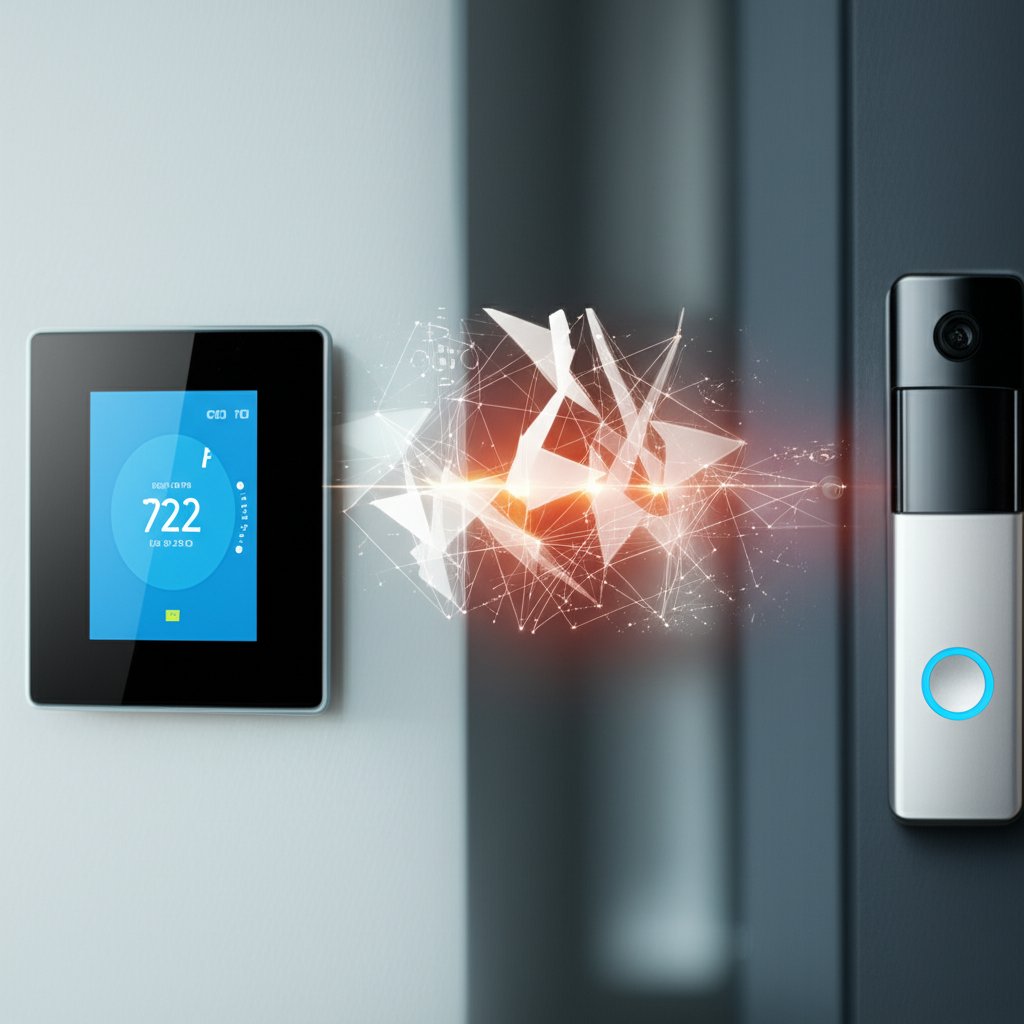The allure of a smart home is undeniably powerful: lights that obey your voice, thermostats that intelligently adapt to your routine, and security cameras that offer peace of mind from anywhere. These conveniences promise a simpler, more efficient life, but they often spark a fundamental question: Is your smart home secretly spying on you? It’s a completely valid concern, and as a security professional, I want to assure you that while data collection is indeed inherent to these devices, understanding the precise risks and taking proactive, concrete steps empowers you to fully embrace smart technology without ever sacrificing your privacy or security. This guide is designed to be your comprehensive resource for IoT device security, equipping you with the knowledge and actionable strategies to take absolute control of your digital home.
Table of Contents
Smart Home Security Basics
What exactly are “smart home” devices?
Smart home devices, frequently referred to as Internet of Things (IoT) devices, are essentially everyday objects embedded with sensors, software, and other technologies that allow them to connect to the internet, send and receive data, and often be controlled remotely. Their purpose is to make your home more automated, efficient, and responsive to your needs.
Consider familiar examples: smart speakers like Amazon Echo or Google Home, learning thermostats such as Nest or Ecobee, video doorbells like Ring or Arlo, or even smart appliances. Each leverages internal components—microphones for voice commands, cameras for visual monitoring, motion sensors for activity detection, and temperature sensors for climate control—to interact with its environment. This intricate connectivity to your home network and the broader internet is what makes them “smart,” but it also introduces a distinct set of security considerations that every homeowner must understand.
How do smart devices collect data?
Smart devices are fundamentally data-driven. They collect a diverse array of information through their embedded sensors, microphones, and cameras, as well as by meticulously tracking your usage patterns and interactions. This data isn’t just a byproduct; it’s absolutely essential for their core functionality.
- Smart Speakers & Voice Assistants: These devices constantly listen for a “wake word.” Once detected, they record your voice commands, which are then transmitted to cloud servers for processing and interpretation. This data allows them to execute tasks, but it also captures your linguistic patterns and potentially personal information spoken aloud.
- Smart Cameras & Doorbells: Equipped with lenses and often microphones, these devices continuously capture video and audio feeds. They may record only when motion is detected, or offer continuous recording, depending on settings and subscription. This data is stored locally or in the cloud and allows you to monitor your property, but also details movements, visitors, and sounds around your home.
- Smart Thermostats: They collect data on your presence, temperature preferences, energy consumption, and even local weather. This allows them to learn your habits, optimize heating/cooling schedules, and integrate with utility providers for energy-saving programs.
- Smart Plugs & Light Bulbs: While seemingly simple, these devices track usage patterns—when lights are turned on/off, how long they stay on, and energy consumption. This data informs automation routines and potentially energy audits.
- Activity Trackers & Health Devices: These collect highly sensitive biometric data, sleep patterns, heart rate, and activity levels, often transmitting them to companion apps and cloud services for health monitoring.
Beyond these direct interactions, most devices also gather diagnostic data, performance metrics, and anonymized usage statistics. This “telemetry data” helps manufacturers identify bugs, push updates, and improve future product iterations. Understanding this fundamental flow of data, from your device to the cloud, is the crucial first step in asserting control over your digital privacy.
Who is collecting your data and why?
Primarily, the device manufacturer is the entity collecting your data. Their primary motivations include improving product functionality, providing essential services, and—in many cases—for internal analytics or marketing purposes. Beyond manufacturers, third-party services that integrate with your devices (e.g., streaming services on a smart TV) might also collect data. The most concerning scenario, however, is when malicious actors gain unauthorized access to your data due to inadequate security measures.
Manufacturers leverage this data to analyze device usage, pinpoint common issues, develop new features, and understand broader user preferences. For example, your smart TV might track viewing habits to offer tailored content recommendations or serve targeted advertisements. While much of this represents legitimate business practice, it’s imperative to distinguish it from unauthorized access. The “why” often balances your convenience with the company’s product development and profit. Your underlying concern, however, should always be the potential for misuse or unauthorized access by cybercriminals, regardless of the initial intent.
Is my smart home actually “spying” on me, or is it just collecting data?
The critical distinction between “data collection” and “spying” hinges on three key factors: consent, intent, and authorized access. Most smart devices collect data for operational purposes, typically with your consent—albeit often hidden within lengthy privacy policies. This, by definition, is not malicious spying. However, the risk of true, unauthorized “spying” becomes alarmingly real when vulnerabilities are exploited by hackers or when device settings are improperly managed.
When you activate a voice assistant, its design dictates it must listen for a specific wake word; this is a form of data collection essential for its function. It is not “spying” in the nefarious sense, unless it proceeds to record and transmit everything without your explicit consent or activation. Conversely, if a cybercriminal exploits a weak password or an unpatched vulnerability to gain unauthorized access to your smart camera or microphone, that absolutely constitutes malicious surveillance or spying. Our goal is to empower you to control that risk and clearly differentiate between a device’s intended function and its potential exploitation.
How can I protect my smart home from unauthorized access?
Protecting your smart home from unauthorized access requires establishing robust digital hygiene practices. This begins with fundamental steps such as implementing strong, unique passwords for every device and your Wi-Fi network. Additionally, consistently keeping your devices updated, enabling two-factor authentication (2FA) whenever available, and diligently reviewing device privacy settings are non-negotiable foundations.
Think of it akin to securing your physical home: you wouldn’t merely lock the front door; you’d also secure windows, perhaps install an alarm system, and routinely inspect for any weak points. Similarly, your smart home demands a multi-layered security approach. Regular software and firmware updates are crucial for patching known vulnerabilities, thereby raising the barrier for cybercriminals. Two-factor authentication adds an indispensable extra layer of defense, ensuring that even if a password is compromised, unauthorized access remains exceptionally difficult. We will delve deeper into these practical, actionable solutions in subsequent sections, providing you with the tools to effectively secure your digital environment.
What are the biggest entry points for hackers into my smart home?
The most common and significant entry points for hackers into your smart home are often surprisingly basic, yet fundamentally critical: weak or default passwords, outdated software or firmware with known vulnerabilities, and insecure Wi-Fi networks. These foundational flaws are the easiest and most frequently exploited by cybercriminals.
- Weak/Default Passwords: Many smart devices ship with easy-to-guess default credentials (e.g., “admin,” “password,” “123456”) or even no password at all, which are prime targets for automated hacking attempts. Using these is like leaving your front door unlocked.
- Outdated Software/Firmware: If you don’t regularly update your devices, they retain known security holes that manufacturers have already patched. Hackers actively scan for these unpatched vulnerabilities, using widely available tools to gain entry.
- Insecure Wi-Fi Networks: Your Wi-Fi network serves as the digital gateway to all your smart devices. If your router has a weak password, outdated encryption (like WEP instead of WPA2/WPA3), or poor configuration, every connected device is immediately at risk. This can allow attackers to snoop on your traffic or even directly access devices.
- Malicious Companion Apps: Downloading unofficial or compromised companion apps can install malware that grants attackers access to your devices or data.
- Phishing/Social Engineering: Attackers might trick you into revealing login credentials through deceptive emails or messages, granting them direct access to your smart home accounts.
Addressing these core areas first can dramatically improve your smart home’s overall security posture and help you protect your digital space effectively. For a comprehensive guide on fortifying your entire home network, especially in today’s remote work environment, further resources are available.
How do outdated software and firmware create risks?
Outdated software and firmware create profound security risks because they invariably contain unpatched vulnerabilities—essentially, digital weaknesses or flaws—that cybercriminals can readily exploit. This exploitation can lead to unauthorized access, compromise of your sensitive data, or even complete control over your smart devices. Manufacturers routinely release updates specifically to fix these security flaws, making their prompt installation absolutely critical for your protection.
Consider this analogy: every piece of software or firmware is like a complex blueprint, and inevitably, some bugs or design flaws (vulnerabilities) are discovered after its release. Once such a vulnerability becomes known, the manufacturer engineers a “patch”—a fix delivered via an update. If you neglect to install this update, your device remains exposed to that specific, known weakness. Hackers are acutely aware of these published vulnerabilities and actively scan the internet for devices running older software, as they know exactly how to exploit them. It’s akin to knowing a particular model of car has a faulty lock and specifically targeting that car because you know how to open it.
Can companion apps for smart devices be a security risk?
Yes, companion apps for smart devices can absolutely represent a significant security risk. These apps frequently serve as the primary control interface and the main conduit for data exchange with your devices. Consequently, vulnerabilities within the apps themselves, or lax security practices when accessing them, can inadvertently provide hackers with a backdoor into your entire smart home ecosystem.
If an app contains coding flaws, it could be exploited to grant unauthorized access to your device’s controls or the data it collects. Moreover, if you use a weak, easily guessable password for the app account, or if your mobile device itself is compromised through malware, hackers could gain complete control over all connected smart devices. To mitigate this, always ensure companion apps are downloaded only from reputable sources (official app stores), kept meticulously updated to their latest versions, and protected with strong, unique credentials. Wherever available, enable two-factor authentication for these app accounts. This holistic approach is indispensable for protecting your entire smart home setup from a mobile entry point.
What are IoT botnets, and how can my devices be involved?
IoT botnets are malicious networks composed of compromised smart devices that have been infected with malware and are controlled by a single attacker, often without the owners’ knowledge. Your device can unwittingly become part of such a botnet if it possesses unpatched vulnerabilities, uses default credentials, or has weak security, allowing cybercriminals to remotely recruit it into their army of compromised devices for larger cyberattacks.
Once your smart speaker, camera, or even smart refrigerator becomes part of a botnet, it can be commanded to participate in large-scale malicious activities. These often include launching distributed denial-of-service (DDoS) attacks against websites (overwhelming them with traffic), sending massive volumes of spam emails, or even mining cryptocurrency, all while consuming your bandwidth and processing power. Because many IoT devices are designed with convenience over robust security, they remain easy targets for botnet creators. Keeping your devices meticulously updated, promptly changing all default passwords, and employing strong Wi-Fi security are absolutely essential steps to prevent your smart home from becoming an unwitting participant in these cybercrimes.
Are data breaches from manufacturers a risk even if my home network is secure?
Yes, unequivocally. Even if your home network is flawlessly secured and your individual devices are locked down, a data breach at the manufacturer’s end or at a third-party service provider can still expose your personal information. These companies often store vast amounts of user account data, device usage logs, and sometimes even sensitive recordings (audio or video) in their cloud servers, making them highly attractive targets for sophisticated cyberattacks.
If a manufacturer’s database is compromised, details such as your login credentials, device usage history, associated email addresses, payment information, and potentially even recorded audio or video data from your home could be leaked to malicious actors, often due to misconfigured cloud storage. This unsettling reality underscores the critical importance of choosing smart devices from reputable companies known for strong data security practices and transparently reviewing their privacy policies. While you have no direct control over a manufacturer’s internal security, you can mitigate your personal risk by providing only absolutely necessary information, utilizing unique passwords for each service, and opting for devices that offer robust end-to-end encryption and granular privacy controls. Your data’s journey extends far beyond your home network.
Advanced Smart Home Protection
How can I implement two-factor authentication (2FA) for my smart devices?
Implementing two-factor authentication (2FA) is one of the most impactful steps you can take to secure your smart home. It adds a crucial second layer of verification beyond just your password, making it significantly harder for unauthorized individuals to access your accounts even if they somehow obtain your password.
Here’s how to implement it:
- Access Account Settings: Log in to the companion app or web portal for your smart device’s primary account. Look for sections typically labeled “Security,” “Account Settings,” “Login & Security,” or “Privacy.”
- Locate 2FA Option: Within these settings, search for “Two-Factor Authentication,” “Multi-Factor Authentication (MFA),” “Login Verification,” or a similar phrase.
- Choose Your Method: Most services offer several 2FA methods:
- Authenticator App (Recommended): Apps like Google Authenticator, Authy, or Microsoft Authenticator generate time-sensitive codes. This is generally the most secure method.
- SMS Text Message: A code is sent to your registered mobile phone number. While convenient, it’s slightly less secure than an authenticator app due to potential SIM-swapping attacks.
- Email: A code is sent to your registered email address. This method is only as secure as your email account.
- Follow On-Screen Prompts: The service will guide you through the setup, which usually involves scanning a QR code with your authenticator app or verifying your phone number/email.
- Save Backup Codes: Many services provide backup codes. Store these in a safe, offline location (e.g., a password manager or encrypted document) in case you lose access to your primary 2FA method.
Important: Not all smart devices or their associated services currently offer 2FA. For those that do, however, it is a non-negotiable security step. If a service doesn’t offer 2FA, ensure your password for that service is exceptionally strong and unique, and consider if you are comfortable with the inherent risk. For an even more advanced approach to identity management, explore the potential of passwordless authentication.
Is a separate IoT network truly necessary, and how do I set one up?
A separate IoT network, often referred to as network segmentation or creating a dedicated guest network, isn’t strictly mandatory for every home, but it is highly recommended for significantly enhanced security, especially in homes with numerous smart devices or for small businesses. Its primary benefit is to isolate your smart devices from your main network, preventing them from being used as a bridge to attack more sensitive devices like your computers, smartphones, or personal data storage.
Why it’s important: Many IoT devices have weaker security protocols, receive less frequent updates, or are more susceptible to vulnerabilities. If one of these devices is compromised, a separate network confines the attacker’s reach, preventing them from easily “pivoting” to your laptop containing sensitive financial documents or your phone with personal photos.
How to set one up:
- Access Your Router Settings: Open a web browser on a computer connected to your primary Wi-Fi network. Type your router’s IP address (commonly 192.168.1.1, 192.168.0.1, or 10.0.0.1) into the address bar and press Enter. You’ll need your router’s admin login credentials (often found on a sticker on the router itself, or in the manual).
- Locate Guest Network Feature: Once logged in, navigate through the settings menu. Look for sections like “Wireless Settings,” “Guest Network,” “Network Segmentation,” or “VLANs.”
- Enable and Configure:
- Enable the Guest Network: Toggle the “Guest Network” feature to ON.
- Assign a Unique Name (SSID): Give your new IoT network a clear, distinct name (e.g., “MyHome_IoT” or “SmithFamily_Guest”).
- Set a Strong Password: Create a unique, complex password for this network. It should be different from your main Wi-Fi password.
- Enable Client Isolation (if available): Look for an option like “Client Isolation” or “AP Isolation.” Enable this if present. This prevents devices on the guest network from communicating with each other, further enhancing security.
- Disable Access to Local Network (if available): Ensure the guest network is configured to prevent devices from accessing resources on your primary network (e.g., shared folders, printers). Most guest network features do this by default.
- Save Settings and Connect Devices: Save your changes. Your router may restart. Once it’s back online, connect all your smart home devices (smart speakers, cameras, lights, etc.) to this newly created guest/IoT network. Keep your computers, phones, and other sensitive devices on your primary, more secure network.
This effectively creates a digital firewall, significantly limiting the potential damage if an IoT device is compromised. For small businesses, this separation is not just recommended, but crucial for isolating office IoT from critical business data and infrastructure, aligning with the core principles of Zero Trust.
What should I look for when researching new smart devices to ensure privacy and security?
Choosing new smart devices wisely is your first and most powerful line of defense. Don’t be swayed solely by features or price; prioritize privacy and security. Here’s a checklist of what to look for:
- Reputable Manufacturer: Stick to established brands with a track record of security and customer support. Research their history for past security incidents and how they handled them.
- Clear & Transparent Privacy Policy:
- Read it: Don’t just click “agree.” Understand exactly what data the device collects, how it’s used, who it’s shared with (and under what circumstances), and for how long it’s retained.
- Data Minimization: Does the company adhere to the principle of “data minimization” (collecting only data essential for functionality)?
- Opt-Out Options: Are there clear ways to opt out of non-essential data collection or marketing?
- Commitment to Regular Updates: The manufacturer should explicitly state their commitment to providing ongoing security firmware and software updates for a reasonable lifespan of the device. Look for evidence of a robust patching schedule.
- Robust Encryption:
- In Transit: Does the device use strong encryption (e.g., WPA2/WPA3 for Wi-Fi, TLS/SSL for cloud communication) when sending data?
- At Rest: Is sensitive data (like video recordings) encrypted when stored locally on the device or in the cloud? Look for “end-to-end encryption” for highly sensitive data like camera feeds.
- Granular Privacy Controls:
- Can you easily disable microphones/cameras when not in use?
- Can you delete collected data (e.g., voice recordings, video clips) from your account?
- Are there options to limit location tracking or restrict data sharing with third parties?
- Multi-Factor Authentication (MFA/2FA): Does the associated app or service offer 2FA for account login? This is a fundamental security requirement.
- Default Security Settings: Does the device ship with strong security defaults (e.g., prompts to change default passwords, 2FA enabled by default)?
- Third-Party Security Audits: Has the device or manufacturer undergone independent security audits or certifications (e.g., UL, ioXt Alliance)?
- No Unnecessary Permissions: Does the companion app request permissions that seem unrelated to its function (e.g., a smart light bulb app asking for your contacts)?
Choosing wisely upfront is your most effective first line of defense against future privacy and security headaches. Invest time in research now to save significant trouble later.
How can a VPN on my router enhance smart home security?
A VPN (Virtual Private Network) implemented directly on your router can significantly enhance the security of your entire smart home by encrypting all internet traffic originating from your home network, including that of your IoT devices. This ensures that any data leaving your smart devices is protected from eavesdropping, interception, and monitoring, even if the devices themselves lack built-in VPN client capabilities.
Here’s why this is so powerful:
- Universal Encryption: Most individual smart devices, such as smart plugs, light bulbs, or even some older smart cameras, do not support installing VPN client software. However, when you configure a VPN directly on your home router, every device connected to that router automatically routes its internet traffic through the VPN. This means your smart speaker’s requests, your camera’s outgoing data, and your thermostat’s reports are all secured with strong encryption before they even leave your home network.
- IP Address Masking: A VPN masks your home network’s public IP address, making it much harder for third parties, advertisers, or malicious actors to track your online activity back to your physical location or identify your smart devices.
- Bypassing Geo-Restrictions: While less about security, a VPN can allow your smart devices (like streaming sticks) to access geo-restricted content by making it appear as if your network is in a different region.
- Protection on Untrusted Networks: If your smart devices communicate with cloud services, a router-level VPN ensures that data is encrypted from your home to the VPN server, even if the cloud service itself uses weaker encryption.
This adds a crucial, overarching layer of privacy and security, making it exponentially harder for your Internet Service Provider (ISP), third parties, or malicious actors to intercept, monitor, or analyze your smart home’s internet communications. You can learn more about how to secure your network further with such tools.
What does the future hold for IoT security, and how can I stay ahead?
The future of IoT security will undoubtedly be dynamic, characterized by both advancements in protection and the perpetual evolution of threats. We can anticipate more sophisticated AI-powered threat detection, the adoption of stronger, mandatory industry-wide security standards, and enhanced user control over data, potentially leveraging emerging decentralized identity solutions. However, as the attack surface grows with more connected devices, maintaining vigilance will remain paramount. To stay ahead, you’ll need to embody a mindset of continuous learning, adapt to new best practices as they emerge, and remain proactive.
We are witnessing a growing push for “security by design,” where devices are engineered with privacy and security as foundational elements from their inception, rather than as an afterthought. Expect more seamless, automatic security updates, the widespread adoption of more robust encryption protocols, and potentially stricter regulatory frameworks that hold manufacturers to account for the security of their products. For you, the homeowner, this translates to:
- Ongoing Education: Regularly seek out and consume news and reputable resources on IoT security trends and emerging threats.
- Prompt Updates: Continue to promptly install all software and firmware updates as they become available.
- Strong Credentials: Never waver from using strong, unique passwords and enabling 2FA wherever possible.
- Cautious Adoption: Maintain a critical and cautious approach when integrating new smart devices into your home, always prioritizing security during your research.
- Network Monitoring: Consider tools that monitor your home network for unusual activity from IoT devices.
The technological landscape will undoubtedly change, but the core principles of proactive, informed security will always remain your strongest and most reliable defense.
Can my smart TV or smart refrigerator really be hacked?
Yes, your smart TV or smart refrigerator can absolutely be hacked, just like any other internet-connected device equipped with software and an operating system. These appliances, if not properly secured with strong, unique passwords and consistent, regular updates, can become significant entry points for cybercriminals to access your home network, compromise your data, or even surreptitiously spy on your activities.
Smart TVs, for instance, are often equipped with cameras and microphones, and outdated software can leave them vulnerable to remote access, allowing attackers to potentially view or listen in on your living room. A compromised smart refrigerator could be used as a stepping stone by hackers to pivot to other, more sensitive devices on your home network, or even be recruited as part of an IoT botnet to launch attacks elsewhere. While the direct implications might seem less severe than a hacked security camera, any compromised device on your network represents a significant security weak point that should never be overlooked. Always ensure these internet-enabled appliances are regularly patched, protected with strong credentials, and their privacy settings are carefully reviewed.
Should I disable voice assistants or smart cameras if I’m concerned about privacy?
Disabling voice assistants or smart cameras is certainly one definitive way to mitigate privacy concerns, but it’s not always a necessary or optimal solution. Often, a more balanced approach—one that involves a deep understanding of their settings and responsible management—is entirely sufficient to maintain your privacy without sacrificing the convenience you value. You have a significant degree of control over how and when these devices are active.
For voice assistants, you typically have options to manually mute microphones, review and delete past voice recordings, or adjust privacy settings to strictly limit data collection and retention. For smart cameras, many models allow you to schedule recording times, define specific activity zones, or manually power them off when you are home and no longer require monitoring. Rather than a blanket disabling, I recommend you focus first on thoroughly understanding each device’s specific privacy controls, meticulously reviewing its privacy policy, and only enabling features you genuinely need. If, after conscientiously reviewing all available settings and understanding the data practices, you still feel uncomfortable with their level of data collection, then disabling them might indeed be the right choice for your ultimate peace of mind.
How often should I check for smart device updates?
You should aim to check for smart device updates at least once a month, or ideally, enable automatic updates if your device and its associated app support this feature. Manufacturers regularly release critical security patches, bug fixes, and feature enhancements, and staying current with these updates is absolutely vital for protecting your devices against newly discovered vulnerabilities and potential exploitation.
Some devices provide convenient notifications when updates are available, often through their companion apps, while others necessitate a manual check within the app or sometimes directly on the device itself. Make it a consistent routine to review all your smart devices for updates, just as you would for your computer, smartphone, or tablet. Promptly installing these updates significantly reduces the risk of exploitation by cybercriminals who actively target known security flaws. Remember, an unpatched vulnerability is, quite simply, an open door for hackers.
What is WPA2/WPA3 encryption, and why is it important for my Wi-Fi?
WPA2 (Wi-Fi Protected Access II) and its successor, WPA3, are the current industry-standard encryption protocols specifically designed to secure your Wi-Fi network. They operate by scrambling, or encrypting, all the data transmitted wirelessly between your router and every connected device in your home. These protocols are fundamentally important because they prevent unauthorized individuals from easily intercepting, reading, and potentially exploiting your internet traffic, including all sensitive data originating from your smart home devices.
Without robust encryption like WPA2 or WPA3, anyone within range of your Wi-Fi signal with basic hacking tools could potentially “eavesdrop” on your network. This means they could capture sensitive information, monitor your online activities, and potentially gather data from your smart devices without your knowledge. WPA3 represents the latest advancement, offering even stronger encryption and improved security features compared to WPA2, making it the preferred and most secure choice for newer routers and devices. Always ensure your Wi-Fi network is configured to utilize at least WPA2 (and ideally WPA3) with a strong, complex, and unique password. This foundational security measure is paramount for protecting your entire smart home ecosystem from external eavesdropping and unauthorized access.
Can simply unplugging a smart device protect my privacy?
Simply unplugging a smart device can indeed provide immediate protection for your privacy from ongoing data collection and potential remote access. By severing the device’s connection to both the internet and its power source, you effectively halt its real-time monitoring capabilities. However, it’s crucial to understand that unplugging alone does not erase any data already collected, nor does it resolve any vulnerabilities that might exist in offline storage or within the manufacturer’s cloud servers.
When a device is unplugged, its microphones and cameras cease to function, and it can no longer communicate with cloud services or receive remote commands. This is an effective and immediate way to stop real-time surveillance. Nevertheless, if the device stored data locally before being unplugged (e.g., an SD card in a camera), that data might still be physically accessible if the device were tampered with. Furthermore, all account information and any data previously uploaded to the manufacturer’s cloud remain stored there, completely unaffected by the device being unplugged. For comprehensive privacy management, unplugging should be combined with managing your privacy settings within the associated app, considering a factory reset, and, if you permanently stop using a device, actively deleting your account and associated data from the manufacturer’s service where possible.
Conclusion
The journey toward a smarter, more convenient home absolutely does not have to come at the expense of your fundamental privacy or security. While it’s an undeniable truth that smart devices collect data and introduce unique cyber risks, it is equally true that you are not powerless. By dedicating yourself to understanding how these devices operate, recognizing potential vulnerabilities, and diligently implementing the actionable steps we’ve meticulously discussed throughout this guide—from establishing strong, unique passwords and enabling two-factor authentication to consistently applying regular updates and securing your Wi-Fi network—you can significantly fortify your digital home.
Your smart home should consistently be a source of convenience, comfort, and enhanced living, not a cause for anxiety or a breeding ground for security concerns. With a proactive mindset and an unwavering commitment to these straightforward yet highly effective security practices, you can fully embrace and enjoy all the transformative benefits that smart technology offers. Do so with the confidence and peace of mind that comes from knowing you’ve taken robust, intelligent measures to protect your personal space, your data, and your digital footprint. Don’t allow fear or uncertainty to deter you from experiencing the advantages of a connected life; instead, empower yourself with knowledge and decisive action. The control is firmly in your hands.
Start small and expand your security efforts over time! Join our smart home community for ongoing tips, troubleshooting, and shared insights to further enhance your digital defenses.









